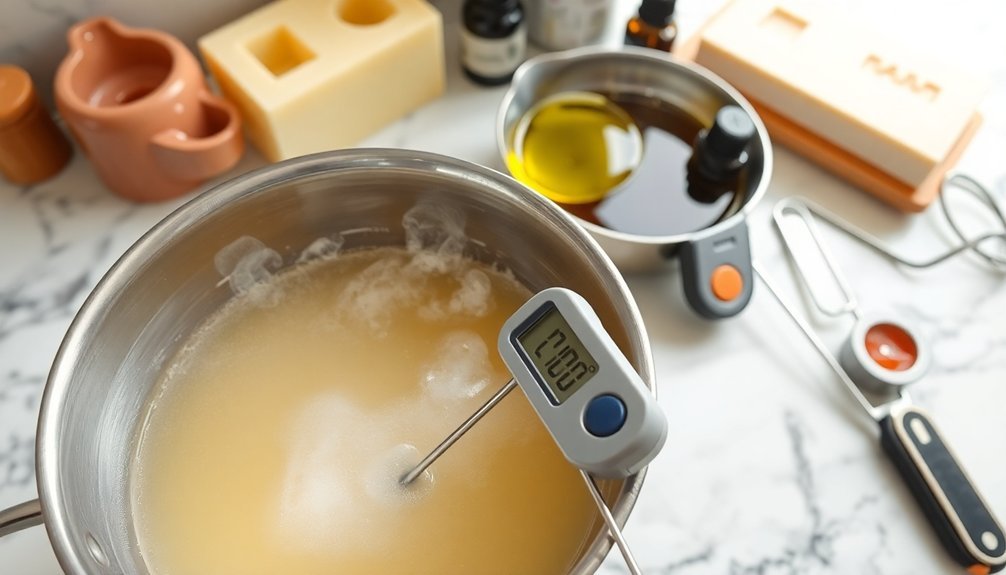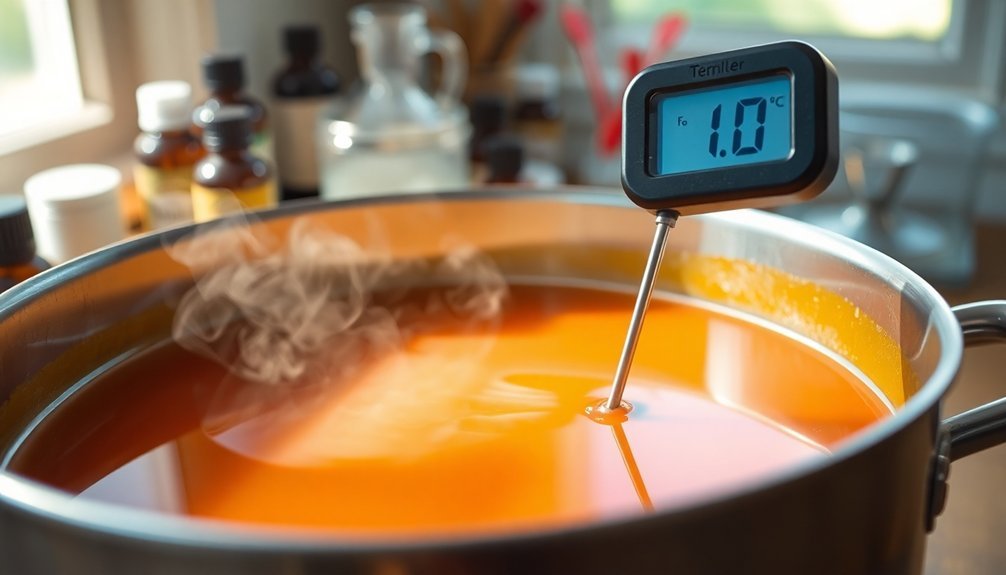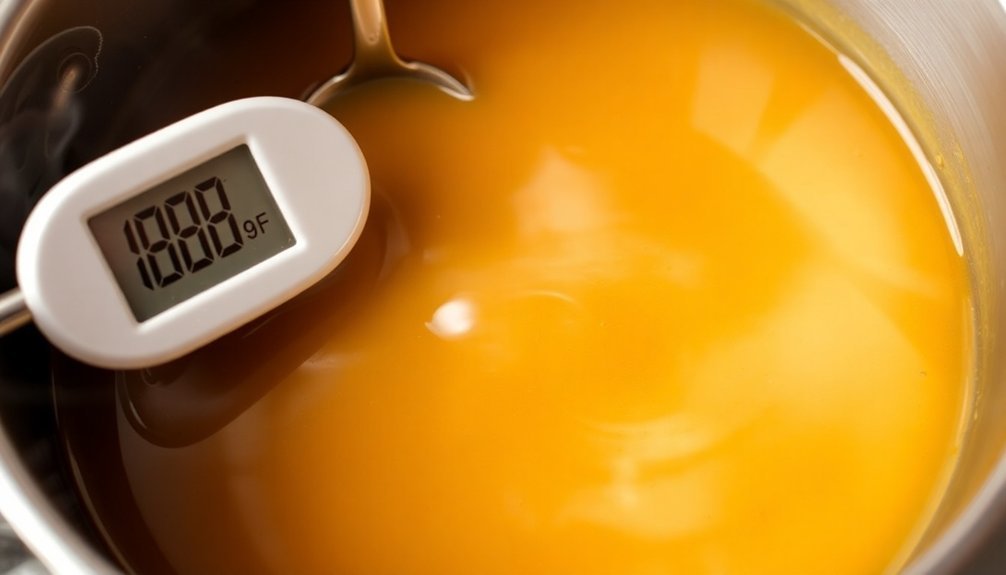To test temperatures for perfect soap, use a digital or infrared thermometer to guarantee oils and lye solution are between 90-110°F (32-43°C) and within 10°F of each other. For cold process soap, aim for 120-130°F for solid oils to prevent false trace. Hot process requires monitoring to keep mixtures below 160°F. Calibrate your thermometer before each session for accuracy. Mastering temperature control will reveal the secret to consistent, high-quality soap batches every time.
How to Test Temperatures for Perfect Soap

While soap making is both an art and a science, achieving the perfect temperature balance is crucial for success.
Using a digital laser thermometer, aim for temperatures between 90°F to 110°F (32°C to 43°C) when combining your oils and lye solution. Experienced soap makers recommend keeping these components within 10 degrees of each other to promote consistent saponification and prevent false trace.
Always verify your oils are completely clear, not cloudy, indicating they've reached proper melting point.
Remember that fresh lye solution can reach 200°F during the exothermic reaction, so allow it to cool to 120-130°F before mixing.
Different temperatures affect your soap's behavior—cooler temperatures work better for intricate designs, while warmer temperatures enhance color vibrancy.
Experiment with various temperature ranges to discover how they influence trace time and your soap's final texture.
The Science Behind Soap Temperature Ranges
Understanding the chemistry behind soap temperatures reveals why precision matters so much in the craft.
The saponification process—the chemical reaction between lye and oils—occurs ideally between 90°F and 110°F (32°C to 43°C). This range guarantees your soap making oils properly react without complications.
When your lye temperatures and oil temperatures differ by more than 10 degrees, you risk problems like premature solidification or accelerated trace.
For cold process soap, aim for 120-130°F (49-54°C) to fully melt solid oils and avoid false trace—when the mixture appears ready but isn't chemically complete.
Coconut oil, with its 76°F melting point, requires special attention.
Keeping your soaping temperature around 85-95°F (29-35°C) prevents the rapid thickening that can ruin intricate designs.
Essential Tools for Accurate Temperature Measurement

Because precision determines success in soap making, investing in reliable thermometers becomes essential for consistent results. A digital laser thermometer offers exceptional accuracy without direct contact with your ingredients, making it ideal for both oil and lye solution measurements.
Infrared thermometers provide quick surface temperature readings, helping you determine when ingredients reach the ideal temperature range before mixing. Alternatively, a candy thermometer can serve your needs effectively, as most can handle temperatures up to 400°F—well beyond soap-making requirements.
Whichever tool you choose, verify it's calibrated properly before each soap-making session. For best results, stick with the same thermometer for all measurements, eliminating variables between batches and guaranteeing accurate temperature measurement every time you craft soap.
Ideal Temperature Ranges for Cold Process Soap
With your thermometer calibrated and ready, you'll need to know exactly what temperatures to aim for during the soap-making process.
The perfect temperature ranges for cold process soap typically fall between 90°F and 110°F (32°C to 43°C) for both your oils and lye solution.
Keep your oils and lye solution within 10 degrees of each other to prevent problems like false trace. Make sure oils appear clear and completely melted at your chosen temperature. If you notice cloudiness, that indicates solidified fatty acids which can cause issues when trace occurs.
Working below 85°F (29°C) risks false trace, especially with hard oils, while temperatures above 120°F (49°C) can accelerate trace too quickly.
For recipes high in soft oils, try the heat transfer method to maintain ideal soap making temperatures throughout the process.
Hot Process Temperature Testing Techniques

To master hot process soap making's heat stages, you'll need to consistently monitor oil temperatures between 120-130°F before adding your cooled lye solution.
Your crock pot provides essential temperature control, creating the ideal environment for saponification when both components meet at their target temperatures.
Using a digital laser thermometer gives you precise readings throughout the process, helping you maintain the careful thermal balance that distinguishes successful hot process soap from problematic batches.
Mastering Heat Stages
Successful hot process soap making hinges on your ability to manage temperature throughout each essential stage.
Start by preheating your pot before adding oils warmed to 130°F. When your lye solution and oils are within 10°F of each other, you'll achieve ideal heat transfer method results and prevent false trace issues.
Monitor both components with a digital laser thermometer for precision. Once combined, keep the mixture below 160°F to avoid glycerin rivers and alien brain formations that can ruin your soap's appearance. Your coconut oil (melting at 76°F) should be completely liquefied before combining with the lye solution.
As saponification progresses, temperature control becomes vital for a successful gel phase.
Maintain consistent heat to guarantee your soap becomes fully emulsified while the higher temperatures accelerate the chemical reaction that transforms your ingredients into soap.
Crock Pot Temperature Control
Managing your crock pot's temperature effectively creates the foundation for successful hot process soap making.
Begin by preheating your crock pot before adding ingredients, which facilitates better melting of solid fats and jumpstarts the saponification process.
Use a digital thermometer to monitor both the crock pot and soap mixture temperature, maintaining the ideal range of 120-130°F (49-54°C). Remember that lye solution can reach 200°F (93°C), so cool it to the recommended range before combining with oils.
Stir your soap mixture gently but continuously to distribute heat evenly and prevent scorching.
Adjust the heat setting as needed throughout the process, avoiding temperatures above 160°F (71°C) which can cause rapid trace and quality issues.
Your attentiveness to temperature control will greatly impact your final soap's texture and quality.
Preventing False Trace Through Temperature Control
False trace can trick you into thinking your soap has reached proper emulsion when it's actually just heat-induced thickening of fats and oils.
You'll get the best results by maintaining your oils and lye solution between 90°F-110°F, keeping them within 10 degrees of each other to create a true emulsion instead of a deceptive false trace.
Your ability to distinguish between actual trace (which indicates saponification has begun) and false trace will dramatically improve your soap's texture and quality.
Recognizing Heat-Induced Thickening
When temperatures aren't properly controlled during soap making, you'll likely encounter heat-induced thickening known as false trace. This deceptive phenomenon occurs when your oils prematurely solidify due to cool temperatures rather than through actual saponification with lye.
You can identify false trace by its grainy, pudding-like appearance that doesn't match the smooth, pudding-like consistency of true trace. If your batch suddenly thickens when working below 84°F (29°C), especially with oils that have higher melting points like coconut oil, you're dealing with false trace.
To avoid this issue, maintain both your oils and lye solution between 90°F and 110°F (32°C-43°C), ensuring they're within 10 degrees of each other. This temperature range keeps oils fully melted while promoting proper saponification for successful soap batches.
Optimal Oil-Lye Ranges
Three key temperature ranges determine your success in preventing false trace during soap making.
First, maintain both your oil and lye solutions between 90°F to 110°F (32°C to 43°C) to guarantee proper saponification. This ideal range activates the chemical reaction without rushing it.
Second, keep your oil and lye temperatures within 10 degrees of each other. When these temperatures diverge too widely, your soap batter may thicken prematurely, giving you a false impression of trace.
Finally, aim for your lye solution to be around body temperature (98.6°F or 37°C) for the smoothest blend.
Watch your oils carefully—if they appear cloudy at your working temperature, they're not fully melted, which risks false trace. A digital laser thermometer will help you maintain these vital ranges with precision.
Emulsion Vs Trace
Understanding the difference between emulsion and trace will save you countless batches from the frustration of false trace. Proper temperature management is your best defense against this common soapmaking pitfall.
When your oils and lye solution are within 10°F of each other (ideally around 100°F), you'll achieve a smooth, properly emulsified mixture that progresses naturally to true trace.
- Keep solid oils completely melted when combining with lye to prevent premature solidification
- Maintain both your oils and lye solution at approximately body temperature (100°F/38°C)
- Watch for smooth, homogeneous texture that indicates true saponification is occurring
- Avoid temperatures below 100°F where hard oils can quickly solidify upon contact with lye
- Look for consistent thickness without graininess as confirmation you've reached true trace rather than false trace
Temperature Adjustments for Different Oil Combinations
Since each oil type brings its own unique melting point to your soap formula, you'll need to adjust your temperature approach accordingly. Coconut oil requires mixing at 29-35°C to prevent rapid trace, while hard oils like palm oil demand higher temperatures around 49-54°C for complete melting.
| Oil Type | Melting Point | Recommended Mixing Temp |
|---|---|---|
| Coconut Oil | 24°C | 29-35°C |
| Palm Oil | 36°C | 49-54°C |
| Cocoa Butter | 34°C | 49-54°C |
| Liquid Oils | N/A | 32-43°C |
For blended formulations, heat your mixture to at least 49°C to avoid false trace. Always match your lye solution temperature within 10 degrees of your oils' temperature for balanced saponification and improved soap quality. This temperature harmony guarantees proper emulsification throughout your batch.
Troubleshooting Common Temperature-Related Soap Issues

When temperature imbalances occur during soap making, several frustrating issues can derail your batch. Your cold process soap success depends greatly on achieving proper temperatures between your lye solution and oils.
- False Trace: If soap batter looks grainy or thickens prematurely, your temperatures are likely too low. Verify oils are fully melted and lye is around body temperature (98.6°F).
- Accelerated Trace: Mixing above 110°F speeds up trace too quickly. Aim for 90-110°F for ideal control.
- Overheating: Temperatures above 120°F can cause alien brain formation or soap volcanoes. Keep your batch cool to prevent these defects.
- Soda Ash: When soap cools too quickly, unsaponified lye reacts with carbon dioxide. Keep oils and lye within 10°F of each other.
- Slow Trace: Cool lye (around 120°F) helps prevent solidifying fats upon contact, enabling proper saponification.
Frequently Asked Questions
How Do You Test the Quality of Soap?
You'll test soap quality by checking texture for smoothness, testing hardness after curing, measuring pH levels (8-10), evaluating color and scent, and doing a water test to verify it doesn't leave residue.
What Kind of Thermometer Do You Use to Make Soap?
You'll want a digital laser thermometer for quick, accurate readings without contact. A probe thermometer also works well for monitoring oils and lye solutions. Remember to calibrate regularly for consistent results in your soap making.
How Can I Test My Soap at Home?
You can test your soap at home by checking its pH with litmus paper, conducting a zap test on your tongue, or using the float test in water to determine if it's properly cured.
How Do You Test if Soap Is Cured?
You'll know your soap is cured when it's firm without indentations, has lost weight, shows a matte finish without sticky spots, and has been resting for 4-6 weeks. pH strips confirm safety.
In Summary
Temperature testing isn't just a technicality—it's the cornerstone of your soap-making success. By investing in quality thermometers, understanding your oil profiles, and maintaining proper temperature control, you'll avoid common pitfalls like false trace and separation. Remember, you're not just making soap; you're creating a chemical reaction that demands precision. Master these temperature techniques, and you'll transform your batches from unpredictable to consistently perfect.





Leave a Reply